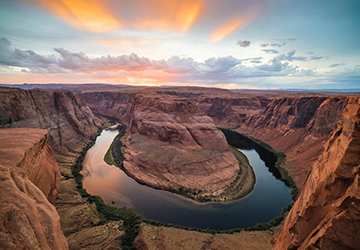Our globe is adorned with a plethora of stunning and luminous natural tableaus. From expansive landscapes cloaked in vivid wildflowers to geological spectacles arrayed in a chromatic spectrum, these vistas captivate photographers, nature lovers, and wanderers alike. This compendium explores some of the world's most colourful places and the unparalleled experiences they offer.
Sequestered in the American Southwest, Antelope Canyon is a veritable masterwork of natural artifice. Its meandering sandstone walls exhibit a palette ranging from deep amethyst to radiant amber, transforming hues as diurnal sunlight percolates through the overhead fissures. This site transcends its status as a mere colourful natural wonder, serving as a sanctuary for photography enthusiasts with its otherworldly vistas.

The Great Barrier Reef, the planet's most extensive coral reef ecosystem, is a preeminent destination for subaqueous exploration. This vibrant marine expanse is adorned with myriad reefs and coral cays, bustling with kaleidoscopic marine life, making it an eminent natural colourful attraction.
As summer unfurls, Provence is transfigured into a breathtaking canvas of purple and lilac hues. Its vast lavender fields offer a sensorial bounty of fragrances, panoramas, and melodies, the quintessential embodiment of the world's most colourful places.
The vast Salar de Uyuni is known as the largest salt flat in the world. It turns into a starry sky during the rainy season, reflecting the sky above. This natural mirror creates a phantasmagoric fusion of cerulean sky and crystalline Earth, spellbinding all who venture there.
Lake Hillier astonishes onlookers with its unusual roseate tint, starkly juxtaposed against the neighbouring ocean's cerulean depths. The lake's vivid pink hue, engendered by unique algal species and elevated salinity, categorizes it as a mesmerizing, natural, colourful attraction.
Embark on a journey to the Zhangye Danxia Landform, where an extraordinary landscape awaits, celebrated for its chromatic, undulating hills. Earthen reds, effervescent oranges, and golden yellows orchestrate a visual symphony that appears almost like brushstrokes on the terrain. This geological marvel, sculpted by mineral deposition and red sandstone erosion, epitomizes a quintessential natural colourful attraction.
Vinicunca heralded as Rainbow Mountain, is distinguished for its dramatic stratifications of mineral-rich sediments. Lavender, marigold, turquoise, and russet bands interlace through the mountain's façade. This elevated trek transcends physical exertion; it is a visual odyssey, securing its reputation among the world's most colourful places.
Frequently dubbed the "River of Five Colors" or the "Liquid Rainbow," Caño Cristales is a spectacle of nature's artistry. For a select few months annually, subaquatic flora beneath the river's surface burgeons, transforming the waters into a dynamic mosaic of hues, including crimson, azure, lemon, tangerine, and emerald. This dazzling display is a paramount exemplar of Earth's colourful natural wonders.
Ventures to these colourful natural wonders offer more than picturesque scenery; they invite observers to witness our world's prodigious diversity and splendour. These locales also furnish educational insights into ecological conservation and nature's fragile equilibrium.
These scenic points are more than tourist attractions; they are pivotal habitats for many species and are integral to their ecosystems, imparting lessons on conservation and environmental stewardship.
These natural, colourful attractions also hold profound cultural significance for the indigenous and local communities. Engaging with these sites provides an avenue to assimilate local traditions and understand the historical connections that bind these communities to their natural environments.
Enhancing your travel experience through active participation in conservation efforts can help preserve these unique landscapes. Many locales offer avenues to engage in conservation tasks or contribute to local organizations that protect these environments.
Interactions with local populations and participation in cultural exchanges can augment one's comprehension of the significance of these sites beyond their visual appeal while also supporting local economies.
The vivid hues prominent in these destinations often act as barometers of ecological health. For example, the luminous coral hues of the Great Barrier Reef indicate robust vitality, whereas bleaching suggests malaise or pathology. Monitoring these chromatic signals yields essential insights into ecosystem viability.
Regions adorned with rich colours are typically biodiversity sanctuaries. The diverse colour palette naturally attracts an eclectic array of pollinators, fostering ecosystem health and continuity. Safeguarding these colourful natural wonders is crucial for the sustenance of global biodiversity.
Patrons of these vibrant locales can enact significant positive change through sustainable practices. Utilizing biodegradable resources, curbing water consumption, and opting for local eco-tours that minimize ecological footprints are instrumental in conserving natural resources.

The vivid sites often embody the cultural essence of the resident communities. Endorsing local handicrafts, engaging in cultural excursions, and honouring indigenous traditions and heritage sites are effective ways for tourists to contribute to perpetuating the cultural narratives that augment these sites.
Pioneering conservation tactics are imperative in the face of escalating environmental concerns. Initiatives such as reforestation, prudent water management, and habitat restoration are increasingly vital near natural colourful attractions. Such endeavours are fundamental to ensuring the resilience and flourishing of these natural spectacles.
Conscientious tourism can act as a formidable conservation lever, generating funds for preservation initiatives and heightening ecological awareness. Travellers can significantly bolster conservation efforts for the world's most colourful places by selecting destinations and tour operators prioritizing environmental sustainability.
The world's most colourful places weave a rich tapestry of experiences steeped in cultural relevance as much as they are in visual allure. Whether you're delving into the vibrant depths of the Great Barrier Reef or meandering through aromatic lavender fields, these colourful natural wonders highlight the breathtaking beauty of our planet and underscore the paramount importance of preserving such marvels for future generations. Set forth on your exploration of these radiant locales and discover the vivid hues of our world.